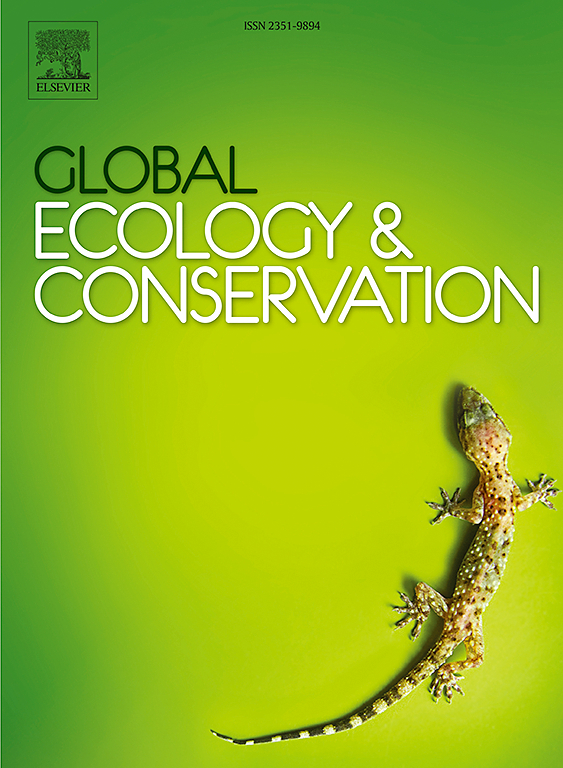基于系统区系学方法研究羌塘高原植物多样性格局的形成与演化
IF 3.4
2区 环境科学与生态学
Q1 BIODIVERSITY CONSERVATION
引用次数: 0
摘要
系统区系学将系统发育信息整合到植物区系的分析中,以阐明植物区系的起源和进化历史。羌塘高原位于青藏高原腹地,是“世界屋脊之脊”,是研究青藏高原乃至全球寒冷干旱植物群起源和演化的天然实验室。本文分析了羌塘高原植物区系的系统发育多样性(PD)以及环境因子对大部分系统发育β多样性的影响,并基于228个完整质体基因组构建的系统发育树推测了物种的分化时间,旨在探讨羌塘高原植物多样性的格局及其进化史。我们利用370种植物的宏观系统发育树对羌塘高原植物区系的PD进行了量化。我们的分析确定了两个不同的系统区,命名为CⅠ和CⅡ,分别对应于高原的东南和西北部门。同时,我们的研究结果表明,这些地区系统发育β多样性的主要气候决定因素是bio15(降水季节性)和bio17(最干旱季降水)。此外,根据化石资料,我们推断该地区种子植物科的出现可追溯到白垩纪(145.00 Ma),自第四纪冰期(2.00 Ma)开始以来,进化速度显著加快。这些发现强调了羌塘高原的隆升和第四纪冰期的气候变化是塑造该地区当代高山植物分布格局的主要驱动因素。本文章由计算机程序翻译,如有差异,请以英文原文为准。
Investigating the formation and evolution of plant diversity patterns in the Qiangtang Plateau based on phylofloristics approach
Phylofloristics integrates phylogenetic information into the analysis of flora to elucidate the origin and evolutionary history of flora. The Qiangtang Plateau, located in the hinterland of the Tibetan Plateau, is the "Roof of the World's Roof," serving as a natural laboratory for studying the origin and evolution of cold and arid flora not only within the Tibetan Plateau but also globally. We analyzed the phylogenetic diversity (PD) of the Qiangtang Plateau flora and the effects of environmental factors on the most phylogenetic beta diversity, and inferred the divergence time of species based on a phylogenetic tree constructed from 228 complete plastid genomes, aiming to explore the pattern of plant diversity and its evolutionary history on the Qiangtang Plateau. We quantified the PD of the Qiangtang Plateau flora utilizing a macro-phylogenetic tree derived from a plant list of 370 species. Our analysis identified two distinct phyloregions, designated CⅠ and CⅡ, corresponding to the southeastern and northwestern sectors of the plateau, respectively, as delineated by their beta diversity. Concurrently, our findings indicate that the primary climatic determinants of phylogenetic beta diversity in these regions are bio15 (precipitation seasonality) and bio17 (precipitation in the driest quarter). Furthermore, using fossil data, we deduced that the emergence of seed plant families in this region dates back to the Cretaceous period (145.00 Ma), with a significant acceleration in evolutionary rates observed since the onset of the Quaternary Ice Age (2.00 Ma). These findings underscore the pivotal role of the uplift of the Qiangtang Plateau and the climatic shifts during the Quaternary Ice Age as primary drivers shaping the region's contemporary distribution patterns of alpine plants.
求助全文
通过发布文献求助,成功后即可免费获取论文全文。
去求助
来源期刊

Global Ecology and Conservation
Agricultural and Biological Sciences-Ecology, Evolution, Behavior and Systematics
CiteScore
8.10
自引率
5.00%
发文量
346
审稿时长
83 days
期刊介绍:
Global Ecology and Conservation is a peer-reviewed, open-access journal covering all sub-disciplines of ecological and conservation science: from theory to practice, from molecules to ecosystems, from regional to global. The fields covered include: organismal, population, community, and ecosystem ecology; physiological, evolutionary, and behavioral ecology; and conservation science.
 求助内容:
求助内容: 应助结果提醒方式:
应助结果提醒方式:


